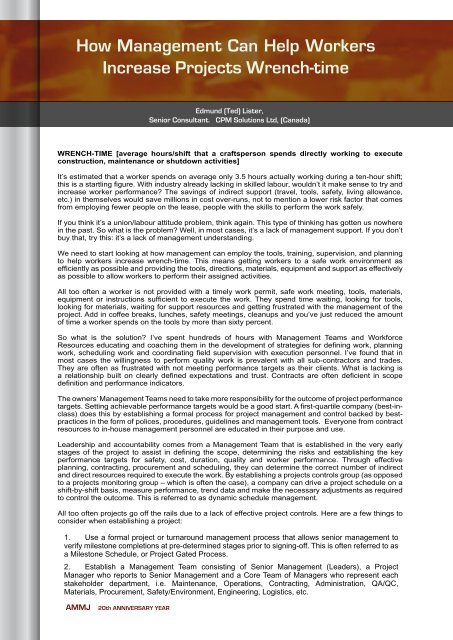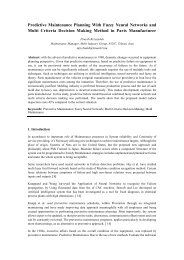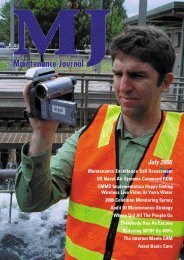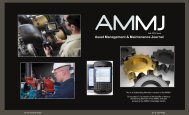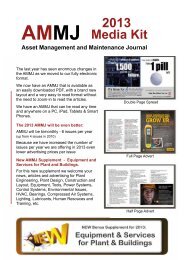DAY 1 - AMMJ
DAY 1 - AMMJ
DAY 1 - AMMJ
- No tags were found...
You also want an ePaper? Increase the reach of your titles
YUMPU automatically turns print PDFs into web optimized ePapers that Google loves.
How Management Can Help WorkersIncrease Projects Wrench-timeEdmund (Ted) Lister,Senior Consultant. CPM Solutions Ltd, (Canada)WRENCH-TIME [average hours/shift that a craftsperson spends directly working to executeconstruction, maintenance or shutdown activities]It’s estimated that a worker spends on average only 3.5 hours actually working during a ten-hour shift;this is a startling figure. With industry already lacking in skilled labour, wouldn’t it make sense to try andincrease worker performance? The savings of indirect support (travel, tools, safety, living allowance,etc.) in themselves would save millions in cost over-runs, not to mention a lower risk factor that comesfrom employing fewer people on the lease, people with the skills to perform the work safely.If you think it’s a union/labour attitude problem, think again. This type of thinking has gotten us nowherein the past. So what is the problem? Well, in most cases, it’s a lack of management support. If you don’tbuy that, try this: it’s a lack of management understanding.We need to start looking at how management can employ the tools, training, supervision, and planningto help workers increase wrench-time. This means getting workers to a safe work environment asefficiently as possible and providing the tools, directions, materials, equipment and support as effectivelyas possible to allow workers to perform their assigned activities.All too often a worker is not provided with a timely work permit, safe work meeting, tools, materials,equipment or instructions sufficient to execute the work. They spend time waiting, looking for tools,looking for materials, waiting for support resources and getting frustrated with the management of theproject. Add in coffee breaks, lunches, safety meetings, cleanups and you’ve just reduced the amountof time a worker spends on the tools by more than sixty percent.So what is the solution? I’ve spent hundreds of hours with Management Teams and WorkforceResources educating and coaching them in the development of strategies for defining work, planningwork, scheduling work and coordinating field supervision with execution personnel. I’ve found that inmost cases the willingness to perform quality work is prevalent with all sub-contractors and trades.They are often as frustrated with not meeting performance targets as their clients. What is lacking isa relationship built on clearly defined expectations and trust. Contracts are often deficient in scopedefinition and performance indicators.The owners’ Management Teams need to take more responsibility for the outcome of project performancetargets. Setting achievable performance targets would be a good start. A first-quartile company (best-inclass)does this by establishing a formal process for project management and control backed by bestpracticesin the form of polices, procedures, guidelines and management tools. Everyone from contractresources to in-house management personnel are educated in their purpose and use.Leadership and accountability comes from a Management Team that is established in the very earlystages of the project to assist in defining the scope, determining the risks and establishing the keyperformance targets for safety, cost, duration, quality and worker performance. Through effectiveplanning, contracting, procurement and scheduling, they can determine the correct number of indirectand direct resources required to execute the work. By establishing a projects controls group (as opposedto a projects monitoring group – which is often the case), a company can drive a project schedule on ashift-by-shift basis, measure performance, trend data and make the necessary adjustments as requiredto control the outcome. This is referred to as dynamic schedule management.All too often projects go off the rails due to a lack of effective project controls. Here are a few things toconsider when establishing a project:1. Use a formal project or turnaround management process that allows senior management toverify milestone completions at pre-determined stages prior to signing-off. This is often referred to asa Milestone Schedule, or Project Gated Process.2. Establish a Management Team consisting of Senior Management (Leaders), a ProjectManager who reports to Senior Management and a Core Team of Managers who represent eachstakeholder department, i.e. Maintenance, Operations, Contracting, Administration, QA/QC,Materials, Procurement, Safety/Environment, Engineering, Logistics, etc.<strong>AMMJ</strong>20th ANNIVERSARY YEAR


